Pulsed FCAW of Martensitic Stainless Clads onto Mild Steel: Microstructure, Hardness, and Residual Stresses
Abstract
1. Introduction
2. Materials and Methods
2.1. Macrostructure and Microstructure
2.2. Hardness Measurements
2.3. Residual Stresses
3. Results
3.1. Macro and Microstructural Analysis
3.2. Statistical Analysis
3.3. Hardness Measurements
3.4. Residual Stresses
4. Discussion
5. Conclusions
- Extensive martensite and bainite formation with preferential crystallographic orientation along the direction of heat extraction in the FZ, which is characteristic of columnar grains after fusion welding, were verified in all tested conditions.
- The different hardness distributions presented an inversely proportional relationship to the applied heat input during cladding. Heat inputs of 0.43, 0.47, and 0.79 kJ·mm−1 resulted in, respectively, 440, 387, and 368 Vickers hardness in the fusion zone near the interface. This occurred because lower heat inputs led to lower dilution, lower cooling rate, and, consequently, lower hardness values in the region near the interface in the FZ.
- The higher the heat input, the larger the grains and the more pronounced is the CGHAZ.
- A higher heat input led to higher compressive residual stress due to higher peak temperatures and broader temperature gradients. Those effects lead to higher thermal stresses, which cause lattice deformation, thus visible as compression stresses at the clad surface.
- The formation of bainitic microstructure in the CGHAZ zone is suggested by a decrement in the band contrast and was more visible in sample 9. Furthermore, it decreased the overall hardness values in the CGHAZ for samples 6 and 9.
- Lower heat inputs lead to lower peak temperatures, rapid cooling rates, and a more refined microstructure in the FGHAZ. In addition, the fine-grained ferrite with low quality of Kikuchi patterns leads to higher hardness values in the FGHAZ, the lower the heat input.
- Higher heat input is more advantageous to clad AWS 410NiMo stainless steel onto low carbon AISI 1020 steel by FCAW due to the low convexity index and smooth hardness transition between FZ and HAZs in addition to the more expressive compressive stresses.
Author Contributions
Funding
Institutional Review Board Statement
Informed Consent Statement
Data Availability Statement
Acknowledgments
Conflicts of Interest
References
- Kahraman, G.; Yücel, H.L.; Taşgin, Y. Identification of optimum working conditions in hydroelectric power plants for cavitation. Eng. Fail. Anal. 2019, 96, 168–174. [Google Scholar] [CrossRef]
- Akthar, A. Field welding of stainless steel hydraulic turbines. Water. Power Dam Constr. 1985, 2, 21–25. [Google Scholar]
- ASTM-A27/A27M-20; Standard Specification for Steel Castings, Carbon, for General Application. ASTM International: West Conshohocken, PA, USA, 2020.
- ASTM-A743/A743M-19; Standard Specification for Castings, Iron-Chromium, Iron-Chromium-Nickel, Corrosion Resistant, for General Application. ASTM International: West Conshohocken, PA, USA, 2019.
- Rao, P.S.; Gupta, O.P.; Murty, S.S.N.; Rao, A.B.K. Effect of process parameters and mathematical model for the prediction of bead geometry in pulsed GMA welding. Int. J. Adv. Manuf. Technol. 2009, 45, 496–505. [Google Scholar] [CrossRef]
- Chattopadhyay, R. High silt wear of hydroturbine runners. Wear 1993, 162–164, 1040–1044. [Google Scholar] [CrossRef]
- López, D.A.; Zapata, J.; Sepúlveda, M.; Hoyos, E.; Toro, A. The role of particle size and solids concentration on the transition from moderate to severe slurry wear regimes of ASTM A743 grade CA6NM stainless steel. Tribol. Int. 2018, 127, 96–107. [Google Scholar] [CrossRef]
- Trudel, A.; Sabourin, M.; Lévesque, M.; Brochu, M. Fatigue crack growth in the heat affected zone of a hydraulic turbine runner weld. Int. J. Fatigue 2014, 66, 39–46. [Google Scholar] [CrossRef]
- Suntiniwat, P.; Warinsiriruk, E.; Joy-A-Ka, S. Single-Pass Cladding Process Using Hot-wire Gas Metal Arc Welding Technique. MATEC Web Conf. 2019, 269, 01006. [Google Scholar] [CrossRef][Green Version]
- Sarafan, S.; Lévesque, J.-B.; Wanjara, P.; Gholipour, J.; Champliaud, H. Distortion and residual stresses in electron beam-welded hydroelectric turbine materials. Sci. Technol. Weld. Join. 2016, 21, 473–478. [Google Scholar] [CrossRef]
- Al Zoubi, W.; Kamil, M.P.; Fatimah, S.; Nashrah, N.; Ko, Y.G. Recent advances in hybrid organic-inorganic materials with spatial architecture for state-of-the-art applications. Prog. Mater. Sci. 2020, 112, 100663. [Google Scholar] [CrossRef]
- Al Zoubi, W.; Ko, Y.G. Chemical stability of synergistic inorganic materials for enhancing electrochemical performance. Compos. Sci. Technol. 2020, 199, 108383. [Google Scholar] [CrossRef]
- Schmeiser, F.; Krohmer, E.; Schell, N.; Uhlmann, E.; Reimers, W. Experimental observation of stress formation during selective laser melting using in situ X-ray diffraction. Addit. Manuf. 2020, 32, 101028. [Google Scholar] [CrossRef]
- Raut, L.P.; Taiwade, R.V. Wire Arc Additive Manufacturing: A Comprehensive Review and Research Directions. J. Mater. Eng. Perform. 2021, 30, 4768–4791. [Google Scholar] [CrossRef]
- Wen, P.; Cai, Z.; Feng, Z.; Wang, G. Microstructure and mechanical properties of hot wire laser clad layers for repairing precipitation hardening martensitic stainless steel. Opt. Laser Technol. 2015, 75, 207–213. [Google Scholar] [CrossRef]
- Ning, J.; Zhang, H.-B.; Chen, S.-M.; Zhang, L.-J.; Na, S.J. Intensive laser repair through additive manufacturing of high-strength martensitic stainless steel powders (I)–powder preparation, laser cladding and microstructures and properties of laser-cladded metals. J. Mater. Res. Technol. 2021, 15, 5746–5761. [Google Scholar] [CrossRef]
- Norrish, J. Advanced Welding Processes. Adv. Weld. Process. 2006, 1–288. [Google Scholar] [CrossRef]
- Bęczkowski, R. Influence of cladding parameters with FCAW on bead geometry with Plackett-Burman experiment used. Arch. Metall. Mater. 2018, 63, 681–687. [Google Scholar] [CrossRef]
- Świerczyńska, A.; Fydrych, D.; Landowski, M.; Rogalski, G.; Łabanowski, J. Hydrogen embrittlement of X2CrNiMoCuN25-6-3 super duplex stainless steel welded joints under cathodic protection. Constr. Build. Mater. 2020, 238, 117697. [Google Scholar] [CrossRef]
- Świerczyńska, A.; Landowski, M. Plasticity of bead-on-plate welds made with the use of stored flux-cored wires for offshore applications. Materials 2020, 13, 3888. [Google Scholar] [CrossRef]
- Nascimento, G.M.S.; Marenda Pukasiewicz, A.G. Analysis of the FCAW deposition process of a chromium carbide alloy applying central composite circumscribed experimental design. Weld. Int. 2018, 32, 579–587. [Google Scholar] [CrossRef]
- Singh, R. Welding Corrosion-Resistant Alloys. In Applied Welding Engineering; Butterworth-Heinemann: Oxford, UK, 2016; pp. 239–262. ISBN 978-0-12-804176-5. [Google Scholar] [CrossRef]
- Meimandi, S.; Vanderesse, N.; Thibault, D.; Bocher, P.; Viens, M. Macro-defects characterization in cast CA-6NM martensitic stainless steel. Mater. Charact. 2017, 124, 31–39. [Google Scholar] [CrossRef]
- Santos, L.L.; Cardoso, R.P.; Brunatto, S.F. Behavior of the reversed austenite in CA-6NM martensitic stainless steel under cavitation. Wear 2020, 454–455, 203322. [Google Scholar] [CrossRef]
- Ross, J.P. Taguchi Techniques for Quality Engineering, 2nd ed.; McGraw-Hill Professional: New York, NY, USA, 1995; ISBN 9780070539587. [Google Scholar]
- ISO/TR 17671-1; Welding—Recommendations for Welding of Metallic Materials—Part 1: General Guidance for Arc Welding. ISO: Geneva, Switzerland, 2020; p. 11.
- Silva, D.C.C.; Scotti, A. Using either Mean or RMS values to represent current in modeling of arc welding bead geometries. J. Mater. Process. Technol. 2017, 240, 382–387. [Google Scholar] [CrossRef]
- Da Cunha, T.V.; Louise Voigt, A.; Bohórquez, C.E.N. Analysis of mean and RMS current welding in the pulsed TIG welding process. J. Mater. Process. Technol. 2016, 231, 449–455. [Google Scholar] [CrossRef]
- ASTM-E3-11; Standard Guide for Preparation of Metallographic Specimens. ASTM International: West Conshohocken, PA, USA, 2017.
- Sedighi, M.; Nazemnezhad, R. Effect of Peak Positioning Method on Accuracy of X-Ray Diffraction Residual Stress Measurement. Exp. Technol. 2016, 40, 295–302. [Google Scholar] [CrossRef]
- Krauss, G. Martensite in steel: Strength and structure. Mater. Sci. Eng. A 1999, 273–275, 40–57. [Google Scholar] [CrossRef]
- Pinto, H.; Corpas, M.; Guio, J.A.; Pyzalla, A.R.; Jahn, A.; Standfuß, J.; Standfuss, J. Microstructure and Residual Stress Formation in Induction-Assisted Laser Welding of the Steel S690QL. Steel Res. Int. 2009, 80, 39–49. [Google Scholar] [CrossRef]
- Mujica, L.; Weber, S.; Pinto, H.; Thomy, C.; Vollertsen, F. Microstructure and mechanical properties of laser-welded joints of TWIP and TRIP steels. Mater. Sci. Eng. A 2010, 527, 2071–2078. [Google Scholar] [CrossRef]
- Coelho, R.S.S.; Corpas, M.; Moreto, J.A.A.; Jahn, A.; Standfuß, J.; Kaysser-Pyzalla, A.; Pinto, H. Induction-assisted laser beam welding of a thermomechanically rolled HSLA S500MC steel: A microstructure and residual stress assessment. Mater. Sci. Eng. A 2013, 578, 125–133. [Google Scholar] [CrossRef]
- Olivio, É.F.T.; Olivio Filho, P.S.; de Aguiar, L.A.; Moreno, J.R.S.; Paredes, R.S.C. Analysis of 410NiMo coating deposited by thermal spray in CA6NM martensitic stainless steel against erosion by cavitation. Int. J. Adv. Manuf. Technol. 2019, 104, 4559–4569. [Google Scholar] [CrossRef]
- Sarafan, S.; Wanjara, P.; Gholipour, J.; Champliaud, H. Global and local characteristics of an autogenous single pass electron beam weld in thick gage UNS S41500 steel. Mater. Sci. Eng. A 2016, 666, 360–371. [Google Scholar] [CrossRef]
- Shojaati, M.; Kashani Bozorg, S.F.; Vatanara, M.; Yazdizadeh, M.; Abbasi, M. The heat affected zone of X20Cr13 martensitic stainless steel after multiple repair welding: Microstructure and mechanical properties assessment. Int. J. Press. Vessel. Pip. 2020, 188, 104205. [Google Scholar] [CrossRef]
- Sarafan, S.; Wanjara, P.; Champliaud, H.; Thibault, D. Characteristics of an autogenous single pass electron beam weld in thick gage CA6NM steel. Int. J. Adv. Manuf. Technol. 2015, 78, 1523–1535. [Google Scholar] [CrossRef]
- Korsunsky, A.M. A Teaching Essay on Residual Stresses and Eigenstrains; Butterworth-Heinemann: Oxford, UK, 2017; ISBN 9780128109908. [Google Scholar]
- Richter-Trummer, V.; Moreira, P.M.G.P.; Ribeiro, J.; de Castro, P.M.S.T. The Contour Method for Residual Stress Determination Applied to an AA6082-T6 Friction Stir Butt Weld. Mater. Sci. Forum 2011, 681, 177–181. [Google Scholar] [CrossRef]
- Thibault, D.; Bocher, P.; Thomas, M. Residual stress and microstructure in welds of 13%Cr-4%Ni martensitic stainless steel. J. Mater. Process. Technol. 2009, 209, 2195–2202. [Google Scholar] [CrossRef]
- Folkhard, E. Welding Metallurgy of Stainless Steel; Springer: Berlin, Germany, 1988. [Google Scholar]
- Francis, J.A.; Bhadeshia, H.K.D.H.; Withers, P.J. Welding residual stresses in ferritic power plant steels. Mater. Sci. Technol. 2007, 23, 1009–1020. [Google Scholar] [CrossRef]
- Prabhu, R.; Alwarsamy, T.; Ramakrishnan, R.; Gargyan, P.S. Development of Mathematical Model for Prediction of Convexity Index in Cladding by Pulsed MIG Welding Process. Procedia Mater. Sci. 2014, 5, 663–668. [Google Scholar] [CrossRef][Green Version]
- Trudel, A.; Lévesque, M.; Brochu, M. Microstructural effects on the fatigue crack growth resistance of a stainless steel CA6NM weld. Eng. Fract. Mech. 2014, 115, 60–72. [Google Scholar] [CrossRef]
- Hanaki, T.; Hayashi, Y.; Akebono, H.; Kato, M.; Sugeta, A. Effect of compression Residual Stress on Fatigue Properties of Stainless Cast Steel. Procedia Struct. Integr. 2016, 2, 3143–3149. [Google Scholar] [CrossRef]
- Mirakhorli, F.; Cao, X.; Pham, X.-T.; Wanjara, P.; Fihey, J.L. Phase structures and morphologies of tempered CA6NM stainless steel welded by hybrid laser-arc process. Mater. Charact. 2017, 123, 264–274. [Google Scholar] [CrossRef]
- Gazder, A.A.; Al-Harbi, F.; Spanke, H.T.; Mitchell, D.R.G.; Pereloma, E.V. A correlative approach to segmenting phases and ferrite morphologies in transformation-induced plasticity steel using electron back-scattering diffraction and energy dispersive X-ray spectroscopy. Ultramicroscopy 2014, 147, 114–132. [Google Scholar] [CrossRef]
- Wang, Y.; Hua, J.; Kong, M.; Zeng, Y.; Liu, J.; Liu, Z. Quantitative analysis of martensite and bainite microstructures using electron backscatter diffraction. Microsc. Res. Technol. 2016, 79, 814–819. [Google Scholar] [CrossRef] [PubMed]

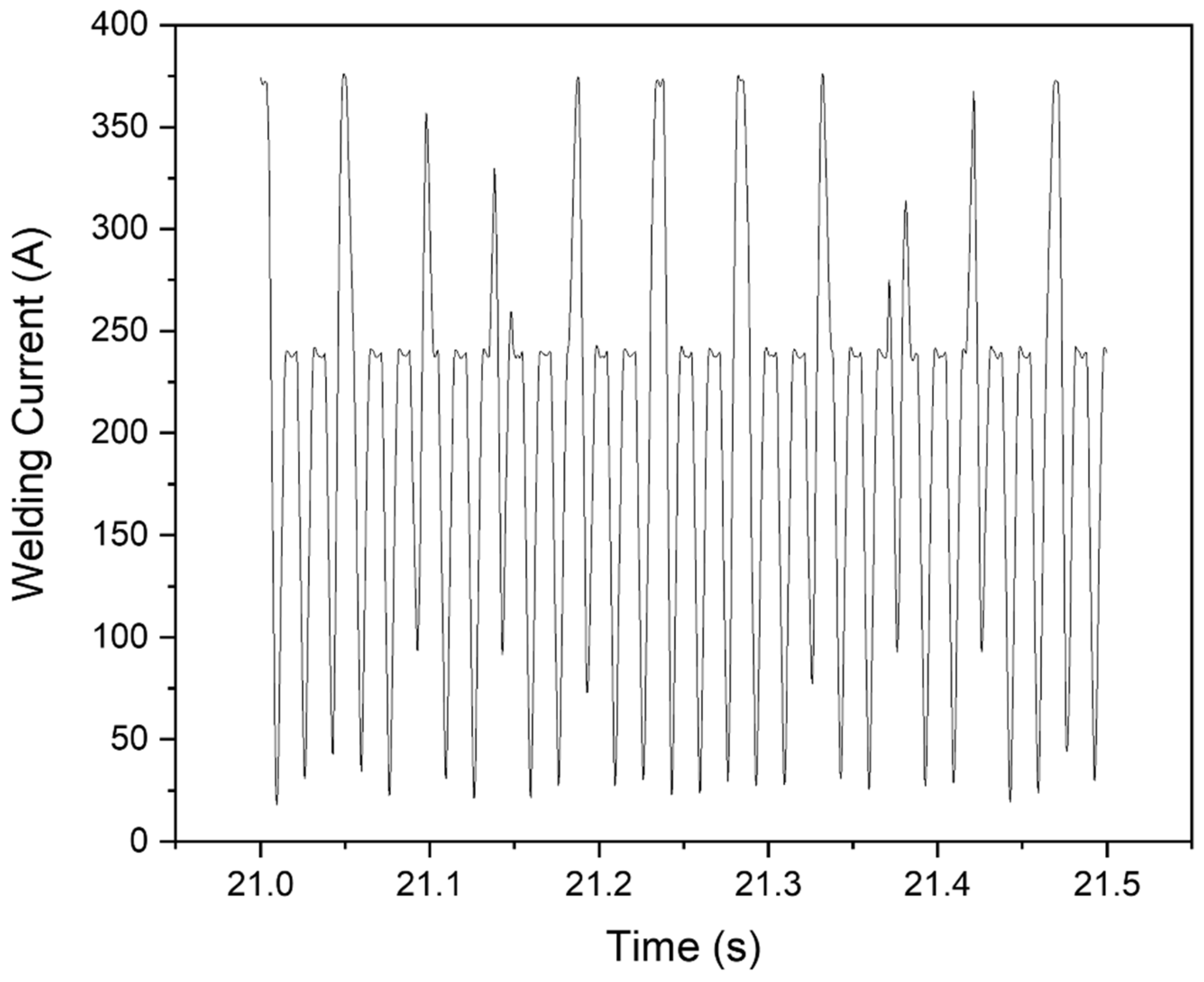
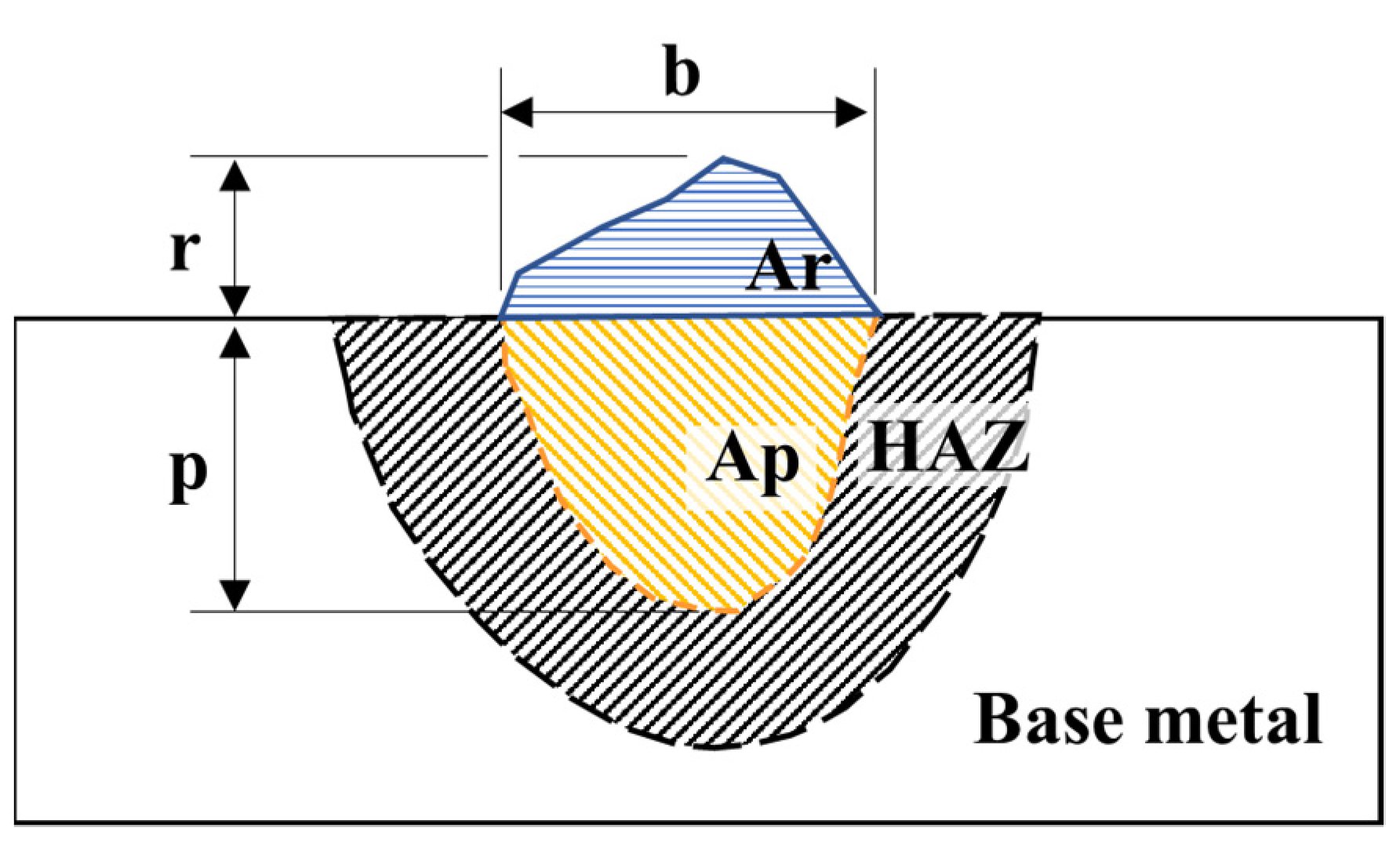
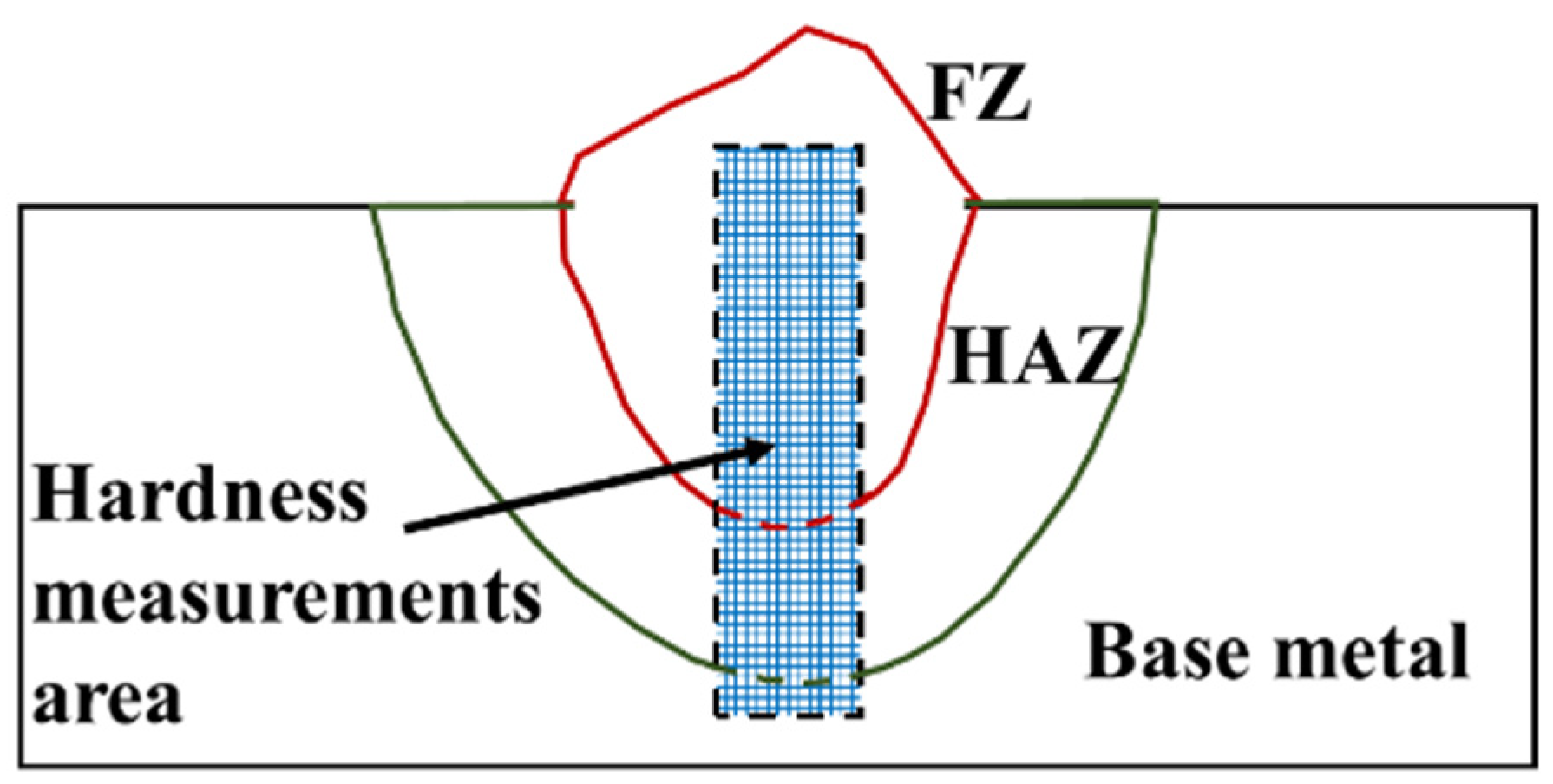
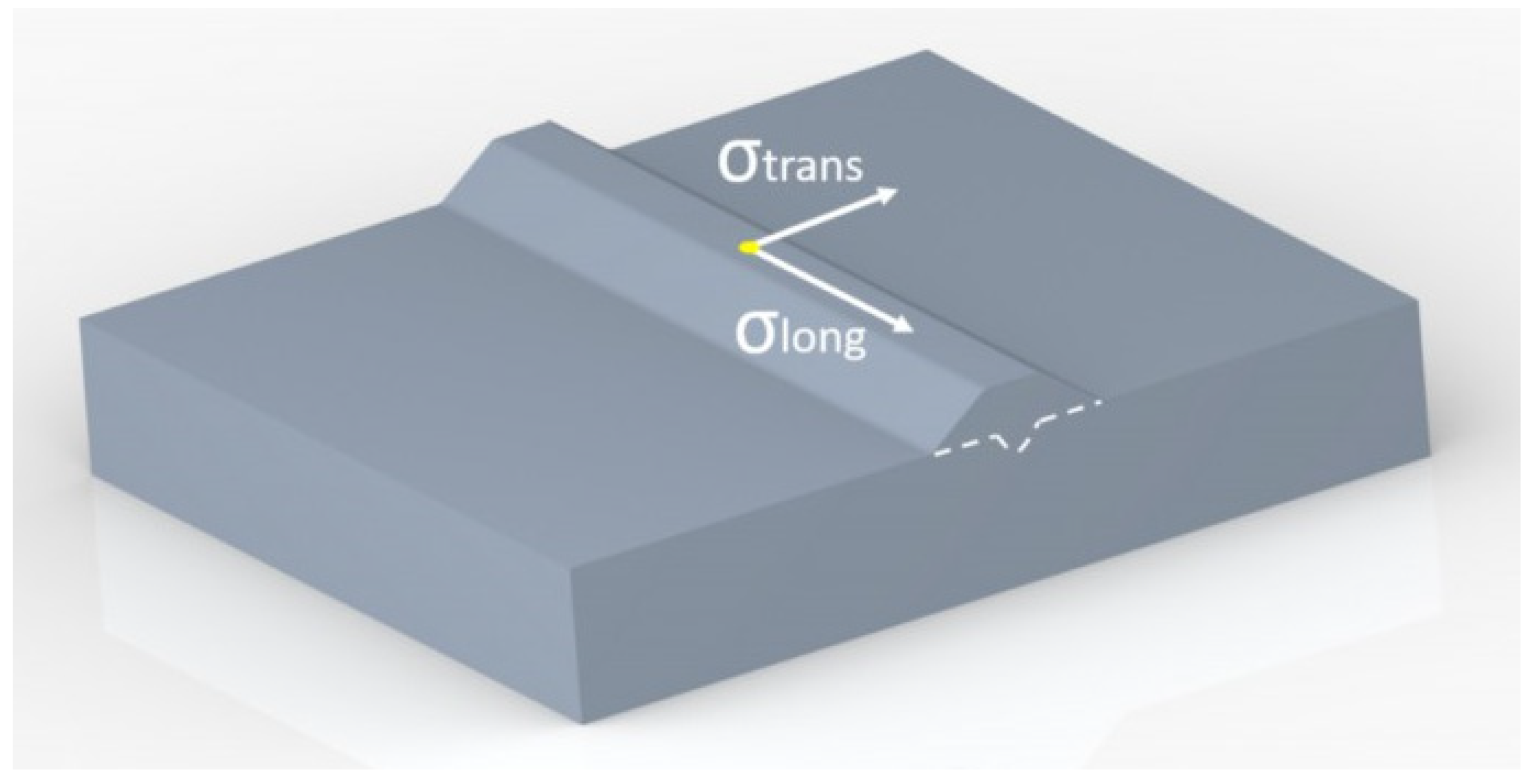

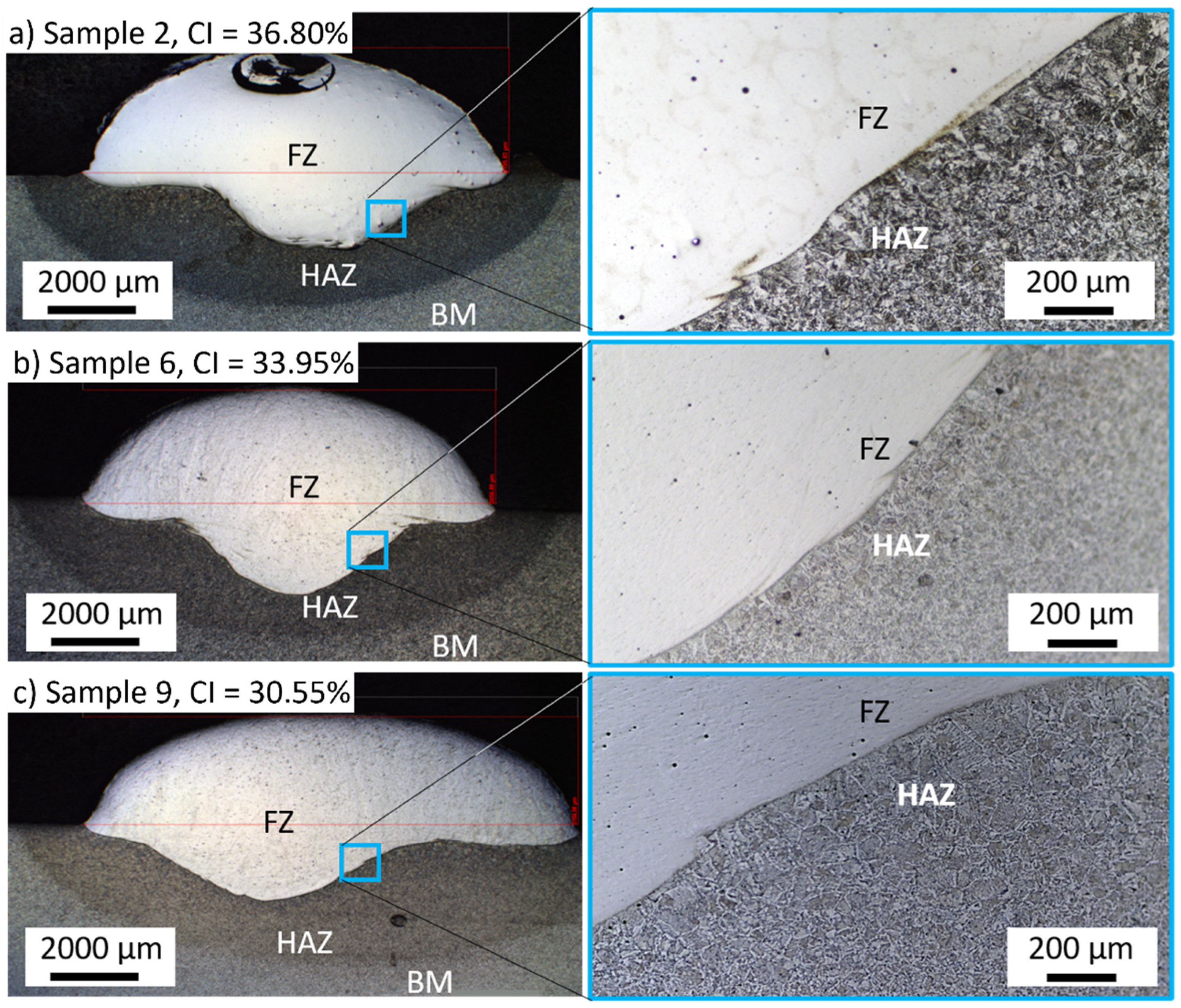
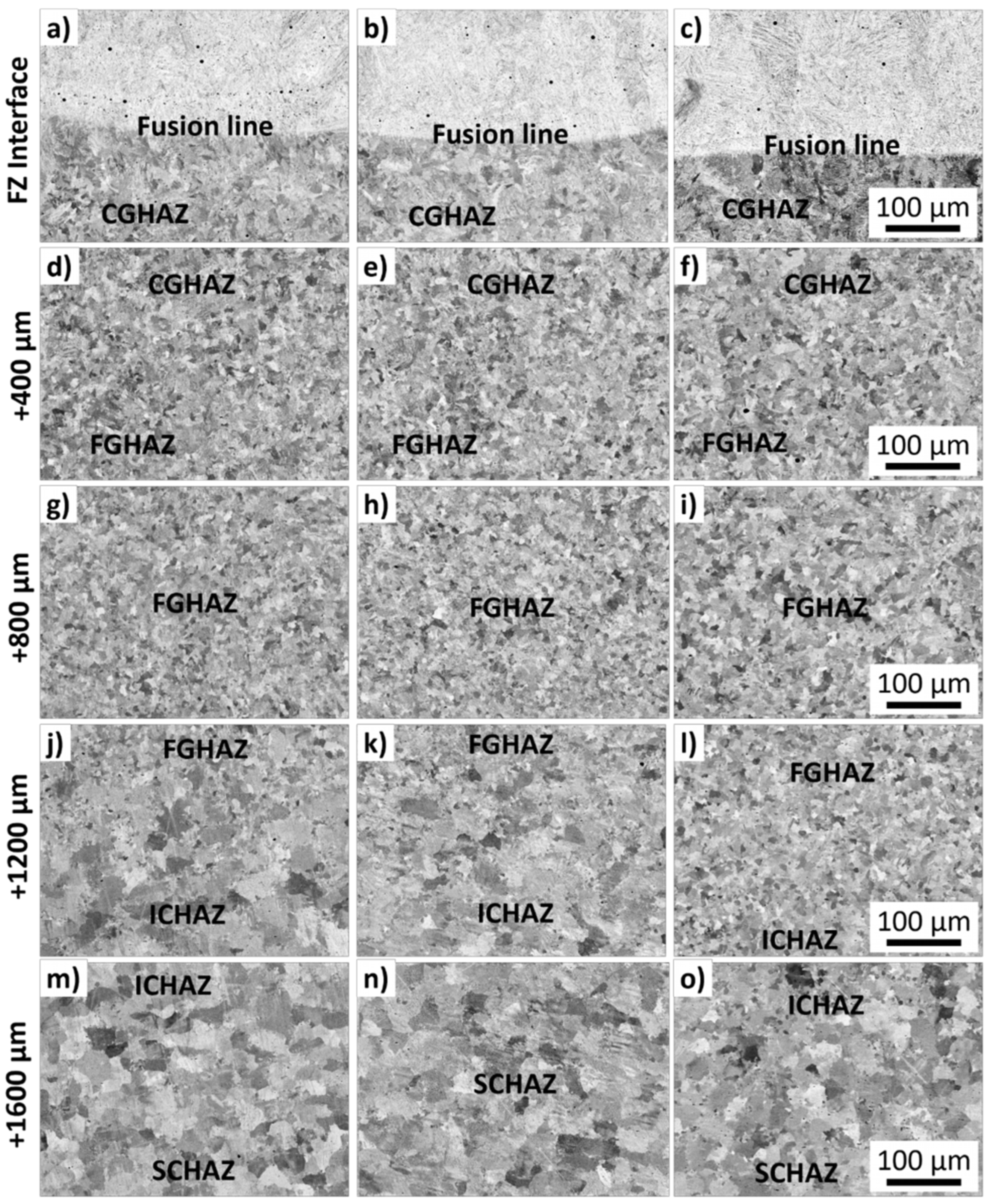
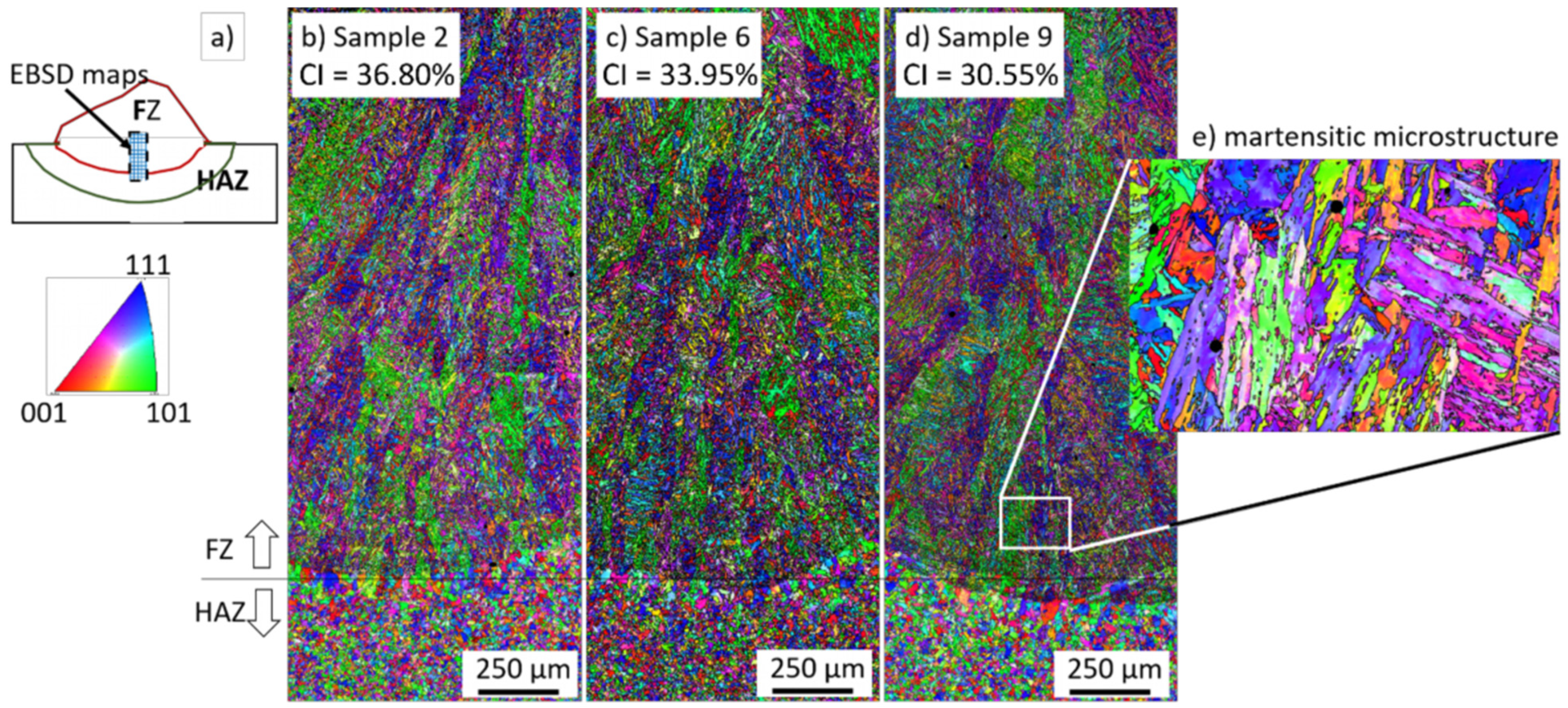

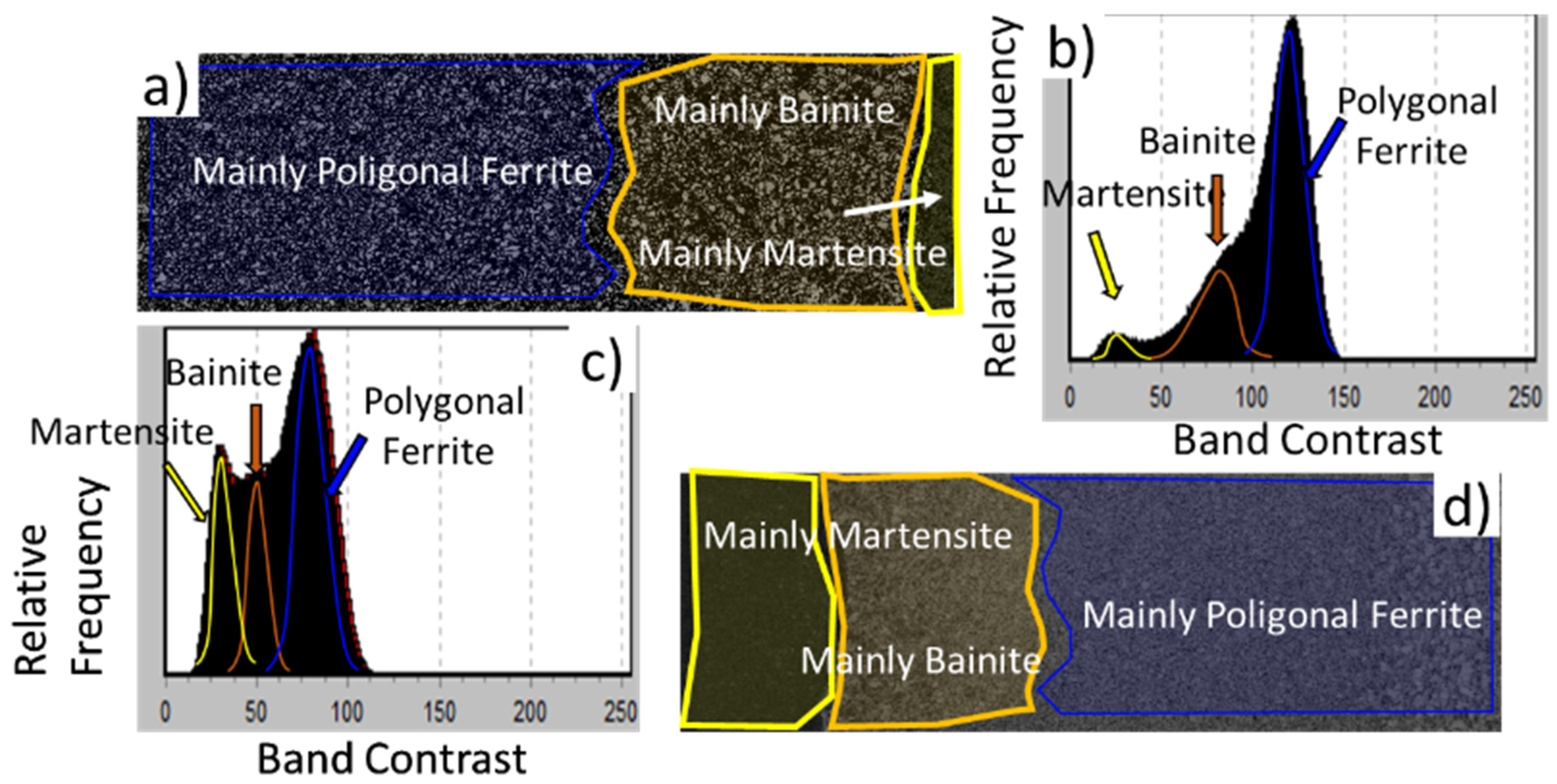
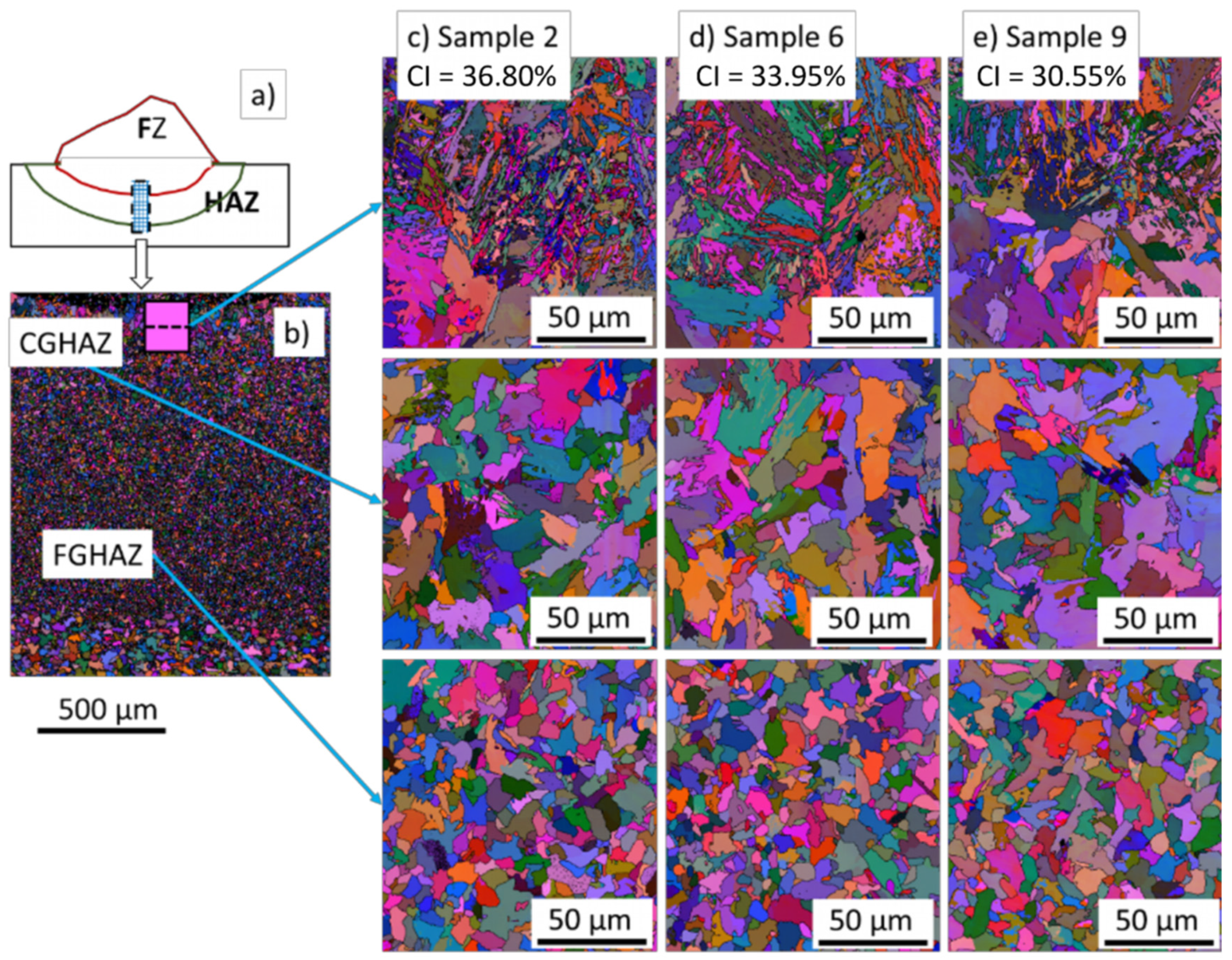
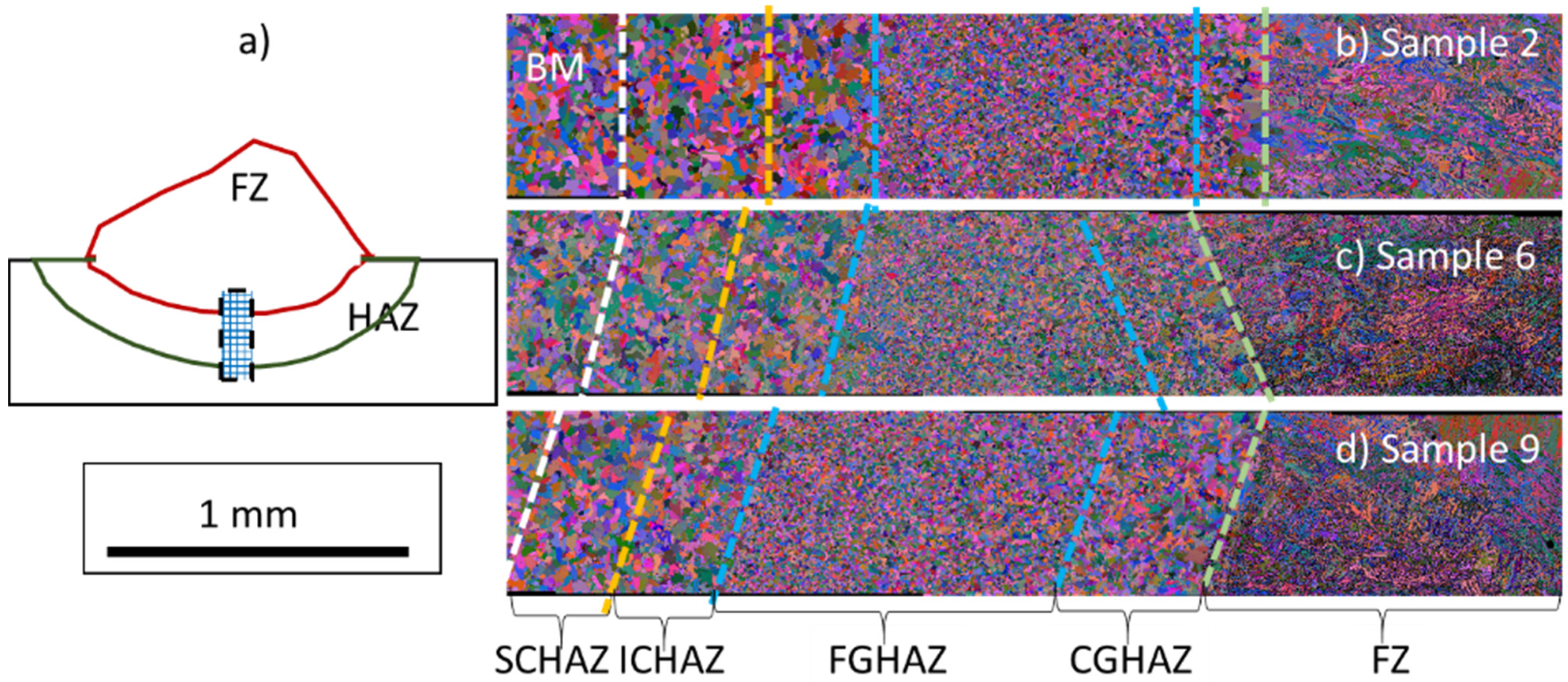



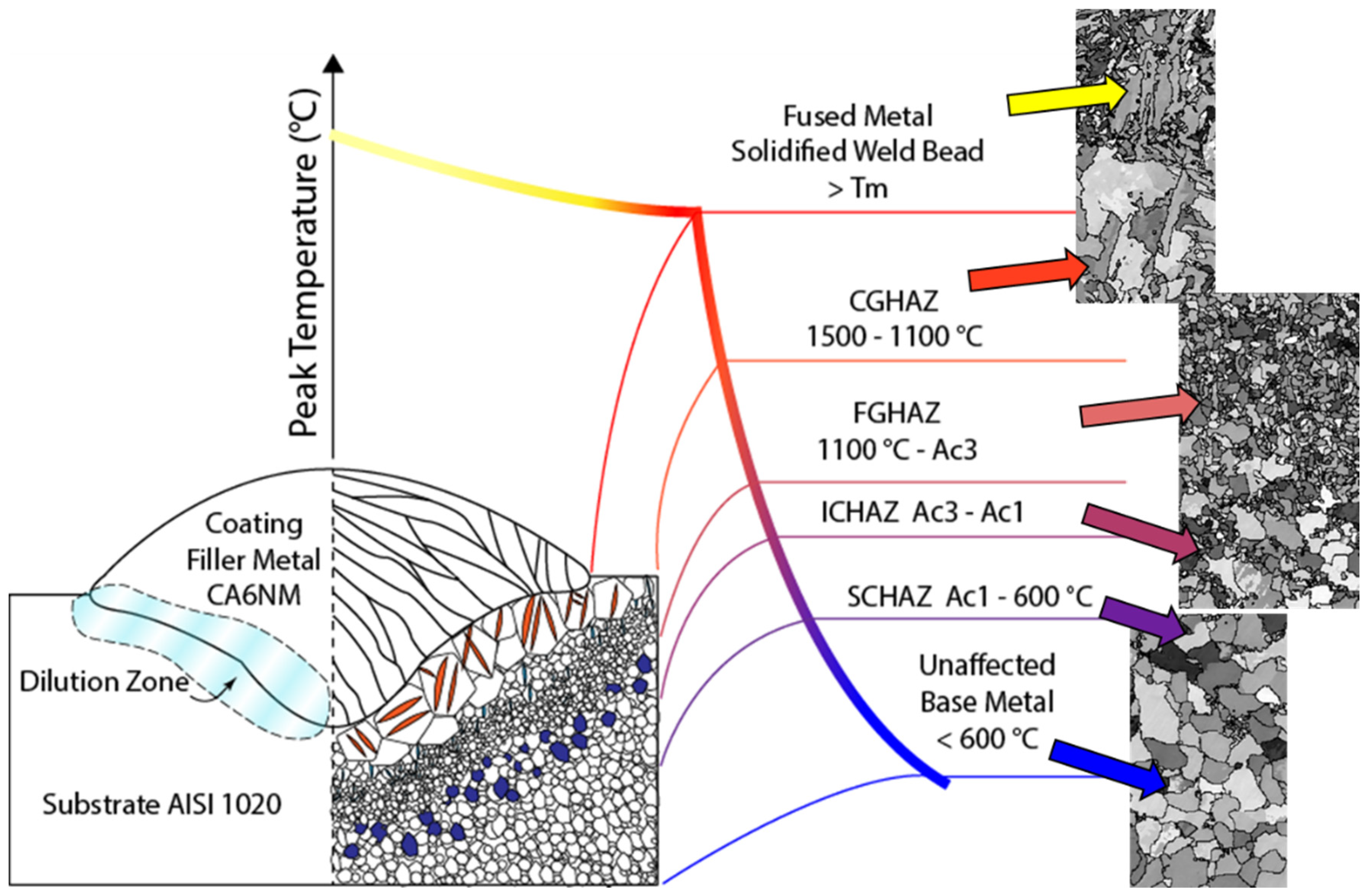
| Material | C | Mn | Si | P | S | Cu | Cr | Ni | Sn | Mo |
|---|---|---|---|---|---|---|---|---|---|---|
| SAE 1020 | 0.21 | 0.49 | 0.19 | 0.03 | 0.035 | 0.20 | 0.15 | 0.14 | 0.06 | --- |
| 410NiMo | 0.027 | 0.59 | 0.44 | 0.024 | 0.006 | --- | 12.5 | 4.86 | --- | 0.43 |
| Sample | Im (A) | Pulse Frequency (Hz) | v (mm·s−1) | CTWD (mm) | Irms (A) | Urms (V) | Q J·mm−1 |
|---|---|---|---|---|---|---|---|
| 1 | 170 | 18 | 5.0 | 30 | 193.3 | 15.2 | 470 |
| 2 | 170 | 22 | 5.8 | 33 | 185.5 | 17.0 | 430 |
| 3 | 170 | 20 | 6.7 | 36 | 160.6 | 17.8 | 340 |
| 4 | 200 | 18 | 5.8 | 36 | 191.4 | 25.5 | 670 |
| 5 | 200 | 20 | 5.0 | 33 | 182.2 | 26.4 | 770 |
| 6 | 200 | 22 | 6.7 | 30 | 178.3 | 22.2 | 470 |
| 7 | 230 | 18 | 6.7 | 33 | 209.9 | 27.8 | 700 |
| 8 | 230 | 20 | 5.8 | 30 | 215.4 | 25.4 | 750 |
| 9 | 230 | 22 | 5.0 | 36 | 195.3 | 25.3 | 790 |
| Sample | Weld Bead Height (mm) | Weld Bead Width (mm) | Penetration Depth (mm) | Convexity Index (%) | ||||||
|---|---|---|---|---|---|---|---|---|---|---|
| r1 | r2 | rAV | b1 | b2 | bAV | p1 | p2 | pAV | ||
| 1 | 4.75 | 4.35 | 4.55 | 9.24 | 8.14 | 8.69 | 1.97 | 2.05 | 2.01 | 52.36 |
| 2 | 3.40 | 3.25 | 3.33 | 8.98 | 9.12 | 9.05 | 1.98 | 1.59 | 1.79 | 36.80 |
| 3 | 4.11 | 4.20 | 4.16 | 8.13 | 7.92 | 8.02 | 1.88 | 1.86 | 1.87 | 51.87 |
| 4 | 3.71 | 3.65 | 3.68 | 10.48 | 9.86 | 10.17 | 2.82 | 2.50 | 2.66 | 36.18 |
| 5 | 4.11 | 4.09 | 4.10 | 10.69 | 11.04 | 10.87 | 2.34 | 2.69 | 2.52 | 37.72 |
| 6 | 3.32 | 3.27 | 3.30 | 9.81 | 9.63 | 9.72 | 2.07 | 2.48 | 2.28 | 33.95 |
| 7 | 3.52 | 3.14 | 3.33 | 9.75 | 10.04 | 9.90 | 2.08 | 2.13 | 2.11 | 33.64 |
| 8 | 3.56 | 3.61 | 3.59 | 10.06 | 10.13 | 10.10 | 2.54 | 2.55 | 2.55 | 35.54 |
| 9 | 3.42 | 3.59 | 3.51 | 11.46 | 11.51 | 11.49 | 2.30 | 2.15 | 2.19 | 30.55 |
| Sample | Welding Parameters | Schematic View of the Cross-Section |
|---|---|---|
| 2 | Im: 170 A; PF: 22 Hz; v: 5.8 mm·s−1; CTWD: 33 mm; CI: 36.80%; Q: 430 J·mm−1 |  |
| 6 | Im: 200 A; PF: 22 Hz; v: 6.7 mm·s−1; CTWD: 30 mm; CI: 33.95%; Q: 470 J·mm−1 |  |
| 9 | Im: 230 A; PF: 22 Hz; v: 5.0 mm·s−1; CTWD: 36 mm; CI: 30.55%; Q: 790 J·mm−1. |  |
| Sample | Welding Parameters | Results | |||||||||
|---|---|---|---|---|---|---|---|---|---|---|---|
| Im | PF | CTWD | b | r | p | Ap | Ar | D | CI | ||
| 2 | 170 | 22.22 | 5.83 | 33 | 9.05 | 3.33 | 1.79 | 8.77 | 27.96 | 2.72 | 36.79 |
| 6 | 200 | 22.22 | 6.67 | 30 | 9.72 | 3.30 | 2.28 | 11.37 | 30.95 | 2.36 | 33.95 |
| 9 | 230 | 22.22 | 5.00 | 36 | 11.49 | 3.51 | 2.19 | 8.50 | 23.99 | 3.08 | 30.54 |
| Factor | b | r | p | Ap | Ar | D | CI |
|---|---|---|---|---|---|---|---|
| x1: Average Current (A) | 0.000 | 0.000 | 0.040 | 0.009 | 0.103 | 0.023 | 0.000 |
| x2: Pulse Frequency (Hz) | 0.706 | 0.094 | 0.391 | 0.647 | 0.308 | 0.854 | 0.470 |
| x3: Welding Speed (mm·min−1) | 0.043 | 0.000 | 0.306 | 0.288 | 0.000 | 0.011 | 0.045 |
| x4: CTWD (mm) | 0.058 | 0.014 | 0.712 | 0.371 | 0.578 | 0.315 | 0.027 |
Publisher’s Note: MDPI stays neutral with regard to jurisdictional claims in published maps and institutional affiliations. |
© 2022 by the authors. Licensee MDPI, Basel, Switzerland. This article is an open access article distributed under the terms and conditions of the Creative Commons Attribution (CC BY) license (https://creativecommons.org/licenses/by/4.0/).
Share and Cite
Moreno, J.S.; Conde, F.F.; Correa, C.A.; Barbosa, L.H.; da Silva, E.P.; Avila, J.; Buzolin, R.H.; Pinto, H.C. Pulsed FCAW of Martensitic Stainless Clads onto Mild Steel: Microstructure, Hardness, and Residual Stresses. Materials 2022, 15, 2715. https://doi.org/10.3390/ma15082715
Moreno JS, Conde FF, Correa CA, Barbosa LH, da Silva EP, Avila J, Buzolin RH, Pinto HC. Pulsed FCAW of Martensitic Stainless Clads onto Mild Steel: Microstructure, Hardness, and Residual Stresses. Materials. 2022; 15(8):2715. https://doi.org/10.3390/ma15082715
Chicago/Turabian StyleMoreno, Joao Sartori, Fabio Faria Conde, Celso Alves Correa, Luiz Henrique Barbosa, Erenilton Pereira da Silva, Julian Avila, Ricardo Henrique Buzolin, and Haroldo Cavalcanti Pinto. 2022. "Pulsed FCAW of Martensitic Stainless Clads onto Mild Steel: Microstructure, Hardness, and Residual Stresses" Materials 15, no. 8: 2715. https://doi.org/10.3390/ma15082715
APA StyleMoreno, J. S., Conde, F. F., Correa, C. A., Barbosa, L. H., da Silva, E. P., Avila, J., Buzolin, R. H., & Pinto, H. C. (2022). Pulsed FCAW of Martensitic Stainless Clads onto Mild Steel: Microstructure, Hardness, and Residual Stresses. Materials, 15(8), 2715. https://doi.org/10.3390/ma15082715









